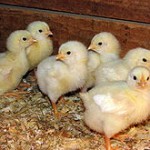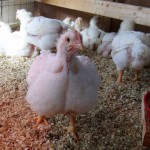by Esmaa Self
Insulted by misleading labeling U.S. laws that allow “free range” to mean the chickens had limited outdoor access, while “natural” meat can include a percentage of injected saline, for after all, salt is natural, and “fresh” chicken can be sold as such even if it has been kept at 30 degrees, we decided it was time to take matters related to the quality of the meat we consumed into our own hands.
Which is a wordy introduction to the following fact: this year we raised and butchered our own meat chickens.

Cornish chicks. Photo courtesy Wiki Commons.
Our goal was not to simply eat cheaply. If price per serving was the only consideration, we’d shop Sam’s Club and save the trouble of raising our own food. No, as always, our goal is to grow excellent food while reducing overall costs (shipping, packaging, additives, bacterial contamination, supporting factory farming). We hoped to produce this higher caliber meat for less than we could buy a locally produced ‘natural’ chicken. And we did. In 11 weeks we raised a baker’s dozen of Cornish roasters, realized 77 pounds (about 35 kilograms) of meat at an amazingly low $1.43 cost per pound. This figure includes butcher paper and freezer bags, feed and lighting, and, of course, the animals. Excluded from the weight are necks, giblets, wing tips, etcetera, reserved for making nutrient rich stock.
Keep in mind that what we produced is not organic meat, for we used a non-medicated, locally produced non-organic feed, however neither is local favorite Red Bird brand organic, and their skinless, boneless chicken breasts sell for $2.99. What we produced is an incredibly tasty, tender and truly farm fresh chicken meat without the factory, the trucking or the non-recyclable packaging.

Our Cornish roasters at 4 weeks
And zero labeling lies.
The chicken meat we’ll eat this winter came from birds that had ample room to move and had their water and bedding cleaned a few times a day. They were neither fed antibiotics nor growth hormones. While the birds themselves were washed prior to slaughter, the meat was not bathed in saline.
Here’s how we did it: I bought an inexpensive plastic kiddie wading pool to house the roasters along with our 2011 laying flock chicks during the first three weeks of life in which the fluffy darlings can die from a draft. The wader surrounded by 2’ (0.6 m) cardboard ‘walls’ made it easy to control their environment. In a few weeks, when both the weather and the chicks were stable, I moved the feathered ones into a garage pen (6’ x 7’ x 3’ or 1.8 x 2.13 x 0.9 m) fashioned from materials already onsite (horse wire, cardboard, and polycarbonate). There they remained until harvest. Elapsed time: 11 weeks.

These birds were raised at a lower elevation & harvested in 7 wks. Photo courtesy Bob & Renee
Due to our location above 5,000 feet of elevation, we rationed the roasters’ feed with a slightly slower growth in mind. Persons living at lower elevations can probably skip this step.
We have butchered two-year-old free-range dual-purpose heritage breed hens before and found Cornish roasters easier to clean, trouble free to raise and yielding a far plumper, juicier and tender meat. Not to mention so much more meat for the effort.
Still unconvinced that growing your own Cornish roasters can be as rewarding as growing your own vegetables? Take a look at this list of pros as we see it:
- Fast growth means less feed expense.
- Fast growth quells family attachment to the meat chickens.
- Fast growth allows garage penning rather than full-on chicken habitat. This low infrastructure approach saves personal and earth resources.
- Garage penning easily keeps chickens safe from their many predators. (In our area those include skunks, roaming dogs, feral cats, cars, coyotes, bears, raccoons, foxes, eagles and other raptors plus weasels.)
- Raising and processing a year’s worth of meat in 11 weeks is time efficient, and unless you are living without a refrigerator/freezer (link http://ditchyourfridge.blogspot.com) your freezer is already running.
- Fast growth means small market or family farms can better juggle the seemingly endless tasks they must accomplish to bring a wealth of food to the plate.

To tenderize the meat naturally, rest it in your refrigerator 24-48 hrs before cutting, wrapping and freezing.
Other tips for raising this backyard meat breed:
Cornish roasters require about two weeks more than do Cornish X Rock, which is the breed most likely in your grocer’s meat aisle. This slower growth (about 2 weeks) makes for fewer leg problems. Indeed, we saw zero leg issues and one of our roosters weighed an amazing 8 pounds (3.6 kg) dressed. Him we butchered at week 10.
These are sedentary birds, so to force mild exercise, while they were young, I placed a roost two inches off the floor in the center of the pen. The birds would have to walk over it to reach the food. Once they reached 5 pounds (2.2 kilograms) live weight (more on that below) I removed the roost, preferring not to risk a stumble which would likely have caused leg issues. Cornish roasters are a clumsy, lumbering breed.
Meting out food for fast growing meat chickens helps arrest heart attack attributed to rapid weight gain. Feeding instructions from Welp Hatchery here.

These breasts weighed 2 lbs each! In this image they're marinating in habanero mustard. We cooked them slowly over mesquite. Delicious!
Free-ranging meat chickens will likely produce leaner meat, but that meat will also likely be tougher. I would not dream of free ranging these meat birds. At least in our predator prone feral hillside property, they would become the proverbial sitting ducks.
You’ll want to provide 2 square feet (0.2 sq. m.) of pen space per bird. I know: conventional wisdom calls for 1 – 1 ½ sq ft. (0.09 to 0.14 sq. m.). Trust me.
You’ll need a one gallon waterer for every 50 birds.
You’ll need one two foot feeding trough for every six birds. Really.
You can have the hatchery vaccinate your birds for coccidiosis and Marek’s at birth and still raise organic meat.

These quarter thighs are ready to be grilled. Happiness is knowing what's in your food.
You can raise meat chicks and layer chicks together for the first three weeks. They are shipped at the same age and can be shipped together. They are indistinguishable upon arrival, but by week three the meat chicks have far outgrown the pullets. After that they need to be separated. But go ahead and keep them in the same area, as the activity level of the layers seems to perk up the Cornish roasters.
A meat bird’s dressed weight is calculated as 70-75% of live weight. Therefore, a bird that weighs 8 pounds (3.63 kilograms) live will yield 5.6 – 6 pounds (2.54 to 2.7 kilograms) of meat. The breasts on our 8-pound rooster were 9 inches (nearly 23 cm.) long and weighed two pounds (900 grams) a piece.
Roosters grow more quickly than do hens. As they mature, roosters may begin to pester hens. It is wise to separate the genders at this time or to butcher the roosters before they cause serious damage. These hybrids are too heavy to mate successfully and they will not produce true-to-breed offspring.
They are quiet birds. That 8 pounder had begun to crow in the final week, however my not-a-morning-guy husband says he didn’t hear the 5:30 AM greetings. I did, but then I am generally up at 5:30 AM.
One can compost the entrails. Simply bury them in 2 feet of yard clippings and there will be no smell while the materials break down and release their nutrients to your eventual soil.
If, like us, you do not yet have the yen for chicken head stew, chicken feet dim sum and prefer your giblets and gravy without detectable giblets, you can use these parts in broth or stock and either utilize the strained result in your cooking or the unstrained version for livestock rations. We do both. I have a dozen and a half frozen packets of trimmed fat, skin and organs that I’ll use this winter to boost the protein level of our laying flock’s mash. In this project, virtually nothing went to waste.
Raising your own meat chickens can be a rewarding way to elevate your mindfulness regarding food. It is also a sure way to know exactly what’s on your plate.
|
|





















0 Comments